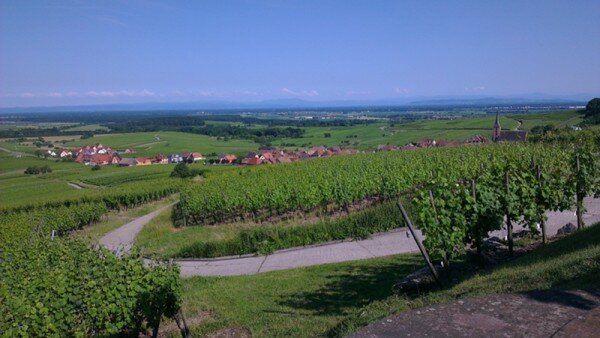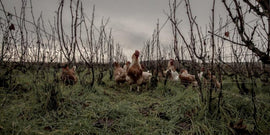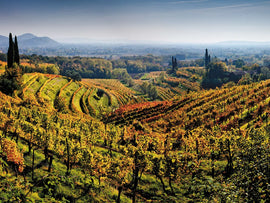Atypical Rosés
As 2024 comes to a close, we find ourselves back in France enjoying some rosés from regions better known for other wines. The Alsace wine region is best known for Rieslings, while Sancerre is more often equated with white wines made from Sauvignon Blanc. But as we’ve learned over the years, you can make rosé pretty much anywhere from pretty much any grape, so we trust that you’ll enjoy these rosés that will help you gain a deeper appreciation for the diversity of winemaking in these renowned regions.
The Alsace AOC, located in northeastern France along the Rhine River and bordering Germany and Switzerland, is renowned for its distinctive white wines and picturesque vineyards. It is one of France's most iconic wine regions, offering a unique combination of French and Germanic influences in its winemaking traditions and culture. The Romans introduced viticulture to the Alsace region in ancient times, and after the fall of the Roman Empire, viticulture was preserved by monasteries, where monks tended vineyards and improved winemaking techniques. In the Golden Ages (13th-15th centuries), Alsace was one of the largest and most prestigious wine-producing regions in Europe. Alsace became part of France in 1648 under the Treaty of Westphalia, introducing French administrative and legal systems to the wine trade. Land redistribution under Napoleon divided large vineyard estates, creating the patchwork of small plots still seen today. In the 1870’s Alsace was annexed by Germany, leading to shifts in wine styles and export markets, but with Germany's defeat in World War I, the Treaty of Versailles (1919) officially returned Alsace and Lorraine to France.
Crémant d’Alsace is a sparkling wine made using the traditional method, often from Pinot Blanc or other local grapes. Crémant and Champagne are made in the same traditional method, where the base wine goes through primary fermentation, then secondary fermentation occurs in the bottle, but Crémants only need to be aged for a minimum of 9 months in bottle, where Champagne must be aged at least 15 months.
The Sancerre wine region is a renowned appellation located in the Loire Valley of France. It is celebrated for producing some of the finest Sauvignon Blanc wines in the world, as well as notable Pinot Noir. It encompasses approximately 15 villages, including Sancerre, Chavignol, and Bué. The Loire River moderates temperatures and protects vines from extreme weather, and its continental climate with warm summers and cold winters make it an ideal environment for viticulture. The region's winemaking also dates back to Roman times when the first vines were introduced to the area, and by the 12th century, Sancerre became a hub for wine production. In the 14th and 15th centuries, the wines of Sancerre gained prominence and were highly sought after by the French nobility. In the 19th century, the arrival of the phylloxera epidemic devastated vineyards across Europe, including Sancerre. When the vineyards were replanted, growers increasingly chose Sauvignon Blanc for its adaptability to the region’s soils and climate. This marked a shift in focus toward white wine production. The Sancerre appellation was officially granted AOC (Appellation d'Origine Contrôlée) status in 1936 for white wines, followed by red and rosé wines in 1959.
Think Pink,
Carrie Upson
|
Domaine Laporte Sancerre Rosé Grandmontains |
|
|
Region/Country of Origin: Loire Valley, France |
About the Vineyards: Domaine Laporte property covers 21 hectares (52 acres) in the heart of the Sancerre appellation, planted with Sauvignon Blanc for the whites, and Pinot Noir for the reds and rosés. Each of our wines is vinified separately, expressing the type of soil on which the vines are grown. This wine comes from a terroir where the Pinot Noir vines are planted on the crest of south, southwest-facing slopes. This privileged location produces a Sancerre that we love to savor for its youth and fruitiness. About the Winemaking: Manually harvested grapes are de-stemmed. After 24 hours of maceration, the vat is bled and the rosé undergoes fermentation at temperatures ranging from 18° to 20°C (64 to 68°F) over 8 days. No malolactic fermentation. The wine is left on its fine lees until bottling at the beginning of April. Tasting Notes: "This dry rosé is uplifting and refreshing, with an underlying Pinot Noir varietal character. Salmon in color, the wine has a nose of orange zest, strawberry, white blossom and dried cranberry. On the palate the wine shows moments of creaminess while remaining bright on the long finish." |
|
Winemaker: Cedric Bourgeois |
|
|
Price per bottle / Price per case: $21.99 btl/ $269.89 cs
|
|
|
Suggested Food Pairing: Grilled veggie skewers, cold cuts, Asian cuisine |
|
|
Hubert Meyer Cremant d’Alsace Rosé |
|
|
Region/Country of Origin: Alsace, France |
About the Wine: The Meyer family has a tradition as vignerons in Blienschwiller that dates back to 1722. In 1976, Hubert Meyer succeeded his father as the head of the domaine. His son, Pierre, returned from his studies of viticulture and oenology to take the torch and continue the tradition in 2009. The wines display finesse and elegance. Precision and balance provide the experience of a lifetime and express the tradition of the Meyer family as well as the historic Alsacian village of Blienschwiller. About the Winemaking: Grapes are manually harvested, then go through a 4-hour slow pressing, 36 hours of cold stabilization, and 2 months of fermentation in stainless steel tanks. Secondary fermentation occurs in bottle, then the bottles are aged sur latte for 18 months. Tasting Notes: The color is a gorgeous pink. The bubbles are elegant and constant expressing beautiful finesse. Bright red fruits along with persistent acidity provides a long finish. |
|
Winemaker: Pierre Meyer |
|
|
Price per bottle / Price per case: $23.99/ $259.09 |
|
|
Suggested Food Pairing: Winter squash, Cream of Mushroom soup, apple pie à la mode |
|





